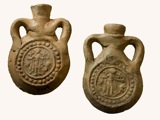Inv. No. 6717
Clay
Presumably from Abu Menas, 5th / 6th century
The pilgrimage site of Abu Menas is situated around 46 km southwest of Alexandria. St. Menas was martyred in the time of Emperor Diocletian (284-305). According to legend, his body was carried to the place where Menas is buried today. The sancturary of Abu Menas flourished from the 5th to the 7th century. Pilgrims from all over the world have traveled to Abu Mena’s sancturary to seek healing and to also take holy water home in circular flasks. This example is decorated with St. Menas, standing as an orans between a pair of camels. Above his outstretched arms a short inscription in Greek reads “Hagios [Saint] Menas”.
Two Flasks
Clay
Presumably from Abu Menas, 5th / 6th century
These two flasks are decorated with the figure of St. Menas who is surrounded by camels, crosses, and inscriptions naming the Saint.
Ovoid
Inv. No. 3262
Faience
From the workshop of Kütahya in Turkey, 18th century
This ovoid was attached to a hanging lamp.
Bowl
Inv. No. 6720
Clay
Bought from Kamel Abdallah, 8th century
This painted bowl has a flat, scalloped rim and is decorated with a plaited pattern. The base of the bowl is adorned with a female bust inside a medallion, surrounded by a frieze of birds, a fantastic animal and a basket with nourishment.

Inv. No. 9065
Clay
Saqqara, Monastery of St. Jeremiah, 7th century
This large storage jar with four handles, showing floral motifs and a fish, was used as a container for liquid or food.
Jar
Inv. No. 10427
Clay
Unknown Provenance, 7th / 8th century
This large painted jar is decorated with birds, animals, rosettes and intersected lines. It was used as a container for food or liquid.




